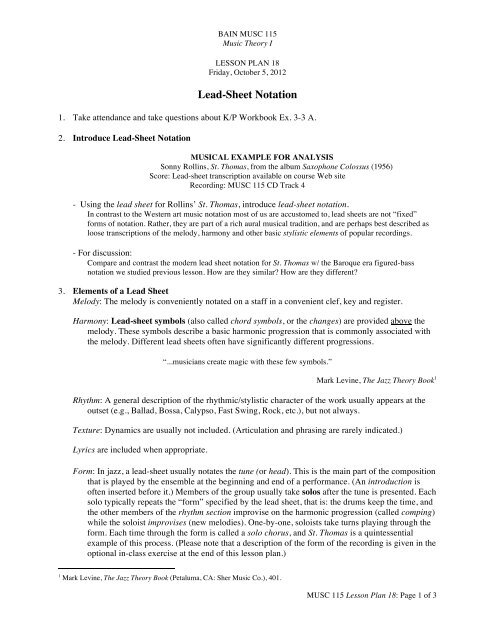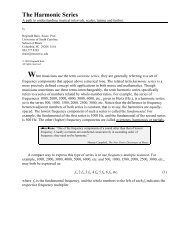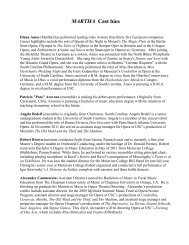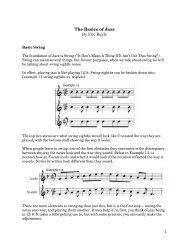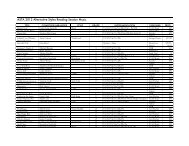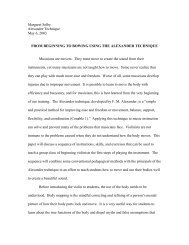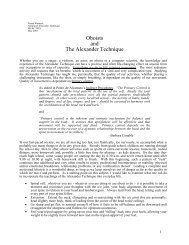Create successful ePaper yourself
Turn your PDF publications into a flip-book with our unique Google optimized e-Paper software.
BAIN MUSC 115<br />
Music Theory I<br />
LESSON PLAN 18<br />
Friday, October 5, 2012<br />
<strong>Lead</strong>-<strong>Sheet</strong> <strong>Notation</strong><br />
1. Take attendance and take questions about K/P Workbook Ex. 3-3 A.<br />
2. Introduce <strong>Lead</strong>-<strong>Sheet</strong> <strong>Notation</strong><br />
MUSICAL EXAMPLE FOR ANALYSIS<br />
Sonny Rollins, St. Thomas, from the album Saxophone Colossus (1956)<br />
Score: <strong>Lead</strong>-sheet transcription available on course Web site<br />
Recording: MUSC 115 CD Track 4<br />
- Using the lead sheet for Rollins’ St. Thomas, introduce lead-sheet notation.<br />
In contrast to the Western art music notation most of us are accustomed to, lead sheets are not “fixed”<br />
forms of notation. Rather, they are part of a rich aural musical tradition, and are perhaps best described as<br />
loose transcriptions of the melody, harmony and other basic stylistic elements of popular recordings.<br />
- For discussion:<br />
Compare and contrast the modern lead sheet notation for St. Thomas w/ the Baroque era figured-bass<br />
notation we studied previous lesson. How are they similar? How are they different?<br />
3. Elements of a <strong>Lead</strong> <strong>Sheet</strong><br />
Melody: The melody is conveniently notated on a staff in a convenient clef, key and register.<br />
Harmony: <strong>Lead</strong>-sheet symbols (also called chord symbols, or the changes) are provided above the<br />
melody. These symbols describe a basic harmonic progression that is commonly associated with<br />
the melody. Different lead sheets often have significantly different progressions.<br />
“...musicians create magic with these few symbols.”<br />
Mark Levine, The Jazz Theory Book 1<br />
Rhythm: A general description of the rhythmic/stylistic character of the work usually appears at the<br />
outset (e.g., Ballad, Bossa, Calypso, Fast Swing, Rock, etc.), but not always.<br />
Texture: Dynamics are usually not included. (Articulation and phrasing are rarely indicated.)<br />
Lyrics are included when appropriate.<br />
Form: In jazz, a lead-sheet usually notates the tune (or head). This is the main part of the composition<br />
that is played by the ensemble at the beginning and end of a performance. (An introduction is<br />
often inserted before it.) Members of the group usually take solos after the tune is presented. Each<br />
solo typically repeats the “form” specified by the lead sheet, that is: the drums keep the time, and<br />
the other members of the rhythm section improvise on the harmonic progression (called comping)<br />
while the soloist improvises (new melodies). One-by-one, soloists take turns playing through the<br />
form. Each time through the form is called a solo chorus, and St. Thomas is a quintessential<br />
example of this process. (Please note that a description of the form of the recording is given in the<br />
optional in-class exercise at the end of this lesson plan.)<br />
1 Mark Levine, The Jazz Theory Book (Petaluma, CA: Sher Music Co.), 401.<br />
MUSC 115 Lesson Plan 18: Page 1 of 3
BAIN MUSC 115<br />
Music Theory I<br />
4. Introduce <strong>Lead</strong>-<strong>Sheet</strong> Symbols<br />
{K/P, pp. 45-47; see also Appendix B <strong>Lead</strong>-<strong>Sheet</strong> Symbols, pp. 546-47)<br />
- Unlike figured-bass symbols (and Roman numerals we will introduce in the next chapter), leadsymbols<br />
are NOT tied to the prevailing key. As jazz theorist Mark Levine puts it: “the key<br />
signature of a lead sheet only affects the melody of the tune, not the chord symbols.” 2 This makes<br />
lead-sheet symbols ideal for describing tertian harmony that is highly chromatic.<br />
- As shown in Fig. 1 below, introduce the symbols for the 4 triad types first, 3 then introduce the 5<br />
seventh chord types. 4<br />
Spell each chord on the board on root C and put the lead-sheet symbol above it. Then ask the students<br />
try to spell selected chords on other roots. Be sure to remind your students that a seventh chord is an<br />
extension of a triad by a third. Also be sure to emphasize that the root of a lead-sheet symbol is always<br />
capitalized.<br />
TRIADS<br />
Quality* <strong>Lead</strong> <strong>Sheet</strong><br />
Symbol**<br />
M C<br />
m Cm or C-<br />
A C +<br />
d C o<br />
SEVENTH CHORDS<br />
Quality* <strong>Lead</strong> <strong>Sheet</strong><br />
Symbol**<br />
Mm<br />
C 7<br />
MM<br />
mm<br />
dm<br />
dd<br />
* - See K/P, Appendix B <strong>Lead</strong>-<strong>Sheet</strong> Symbols for more information.<br />
** - For a chord whose root is C.<br />
C maj7<br />
Cm 7 or C- 7<br />
C Ø7 or C- 7(ß5)<br />
Fig. 1. <strong>Lead</strong>-sheet symbols for the 4 triad types and 5 common seventh chord types.<br />
- Be sure to discuss the “m7(ß5)” symbol. ß5 means lower the fifth of the chord by a half step. 5 A mm<br />
chord with its fifth lowered by a half step is equivalent to K/P's half-diminished seventh chord.<br />
- Briefly touch upon the concept of a slash chord. The bass of a lead-sheet symbol is assumed to be<br />
the root unless otherwise specified. If a different bass note is required, including notes that do not<br />
belong to the chord, it is indicated using the slash symbol "/" followed by the bass note: e.g., C/E,<br />
C/G, C/Bß, C/Fƒ, etc.<br />
2 Ibid.<br />
3 Introduce, but do not over emphasize, the symbol C 6 (a modern harmony called the added-tone triad which adds a coloristic M6<br />
above the root to a major triad). This chord appears in the St. Thomas lead sheet, but has been removed from the homework<br />
worksheet. We will discuss this chord more fully in MUSC 116.<br />
4 By the way, this is a great opportunity to review seventh chord spelling as necessary.<br />
5 Correspondingly, ƒ5 means raise the fifth of a chord by a half step. These are called alterations. Interested students will find this<br />
explained more fully in K/P Appendix B.<br />
C o7<br />
MUSC 115 Lesson Plan 18: Page 2 of 3
BAIN MUSC 115<br />
Music Theory I<br />
OPTIONAL IN-CLASS EXERCISE<br />
Discuss how Sonny Rollins' ensemble turns the notated lead sheet into a full-length "composition" for the<br />
recording.<br />
Sonny Rollins, St. Thomas from the album Saxophone Colossus (1956). Prestige Records.<br />
The players on the recording are:<br />
Sonny Rollins, tenor sax; Tommy Flanagan, piano; Doug Watkins, bass; Max Roach, drums.<br />
Questions for discussion include: What is the role of improvisation in this work? What's the role of the<br />
tenor sax? What's the role of the piano? What's the role of the bass? What's the role of the drums? What's<br />
the form of the head? 6 How is the drum solo related to the head? Etc.<br />
Here is the recording's form, in case you want to discuss it in detail:<br />
Introduction (16 bars, drums)<br />
Head (16 bars, 2x, tenor)<br />
Solos<br />
Tenor sax solo 7<br />
Drum solo 8<br />
Tenor sax solo (again)<br />
Piano solo<br />
Head (16 bars, 2x)<br />
HOMEWORK<br />
1. Worksheet 3-1 (pdf)<br />
2. Read Recognizing Chords in Various Textures, pp. 49-50<br />
MATERIALS<br />
1. St. Thomas <strong>Lead</strong> <strong>Sheet</strong> (pdf)<br />
2. Worksheet 3-1 (pdf)<br />
3. MUSC 115 CD Track 4<br />
6 16 bars: a a b c; 4 + 4 + 4 (2+2) + 4. Notice how c is a quasi-new idea built from b and a.<br />
7 A link to a transcription Sonny Rollins's tenor sax solo (by Jeff Ellwood) is available under Lesson 18.<br />
8 Notice that the drummer carefully follows/articulates the form.<br />
MUSC 115 Lesson Plan 18: Page 3 of 3


